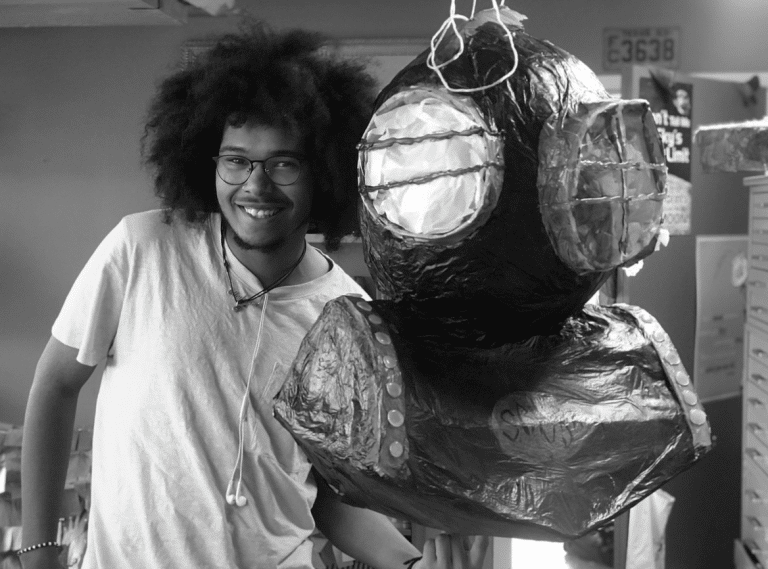
By Deborah Parizek
There are roughly 1,080 teaching hours in a school year. But just how many of those hours are being used to create energy and synergy in our learning environments?
For many of us, the answer is, “not nearly enough.”
At schools across the country, we’re being cornered into a tricky place that can actually squash energy and create a less-than-vibrant school atmosphere. We are often force-feeding curriculum to meet standards and to beat neighboring schools’ performance scores, but not really catalyzing our teachers to pursue creativity nor our students to acquire a thirst for knowledge.
Design Thinking is one approach to wriggling out of that dark corner and creating a better place for thinking, learning, and teaching.
What is Design Thinking?
In the simplest terms, Design Thinking is a process for reframing problems, acting on them, and checking assumptions. It involves investigation, empathy, ideation, and feedback. Do-overs and retries are encouraged and part of the ongoing process.

Design Thinking works best in a school culture built on support, respect and collaboration, but by virtue of the process itself, it also helps to create that culture.
While Design Thinking has been around for decades (think back to Buckminster Fuller), it’s only in the past 10 years we’ve begun using it at HFLI to create a more dynamic learning environment in primary and secondary schools. We’ve found ways to adapt it to student learning, teacher engagement, leadership growth, and overall school culture.
In this article, we look at how Design Thinking can help develop an energetic school and engage everyone from parents to principals in creating change based on a better understanding of each other and the situations that surround us. Through examples, we will look at how Design Thinking can make an impact in the school classroom, conference room, and community.
Captivating students
By promoting inquiry-based learning, Design Thinking helps students see the big picture, question assumptions, and make connections.
At Henry Ford Academies’ four urban schools (in Detroit and Dearborn, Michigan, and San Antonio, Texas), the Design Thinking approach is woven into daily learning, larger assignments, and even school-wide challenges.
For example, juniors in English language arts and social studies classes in Detroit were challenged to “design a way to tell the story of people who are no longer here to tell their own story” as part of a unit about the stages of genocide.
Teachers hosted a Holocaust survivor at the school to talk about her experiences and create a powerful opportunity for the students to gain empathy. When the discussion wrapped up, teachers couldn’t get the students back to class because they wanted to learn more about how she found the strength to carry on with so much adversity.
Afterwards, teachers had students write individual letters to the survivor, and the writing was powerful. Students, especially struggling students and those who usually did the bare minimum, put extraordinary effort into the work. It was very effective, encouraging students to get involved at that level, and learning the importance of capturing her story for future generations.
Planning for assignments that incorporate Design Thinking can be quite difficult. In the best-case scenarios, students are given the ability to determine their own interventions, but sometimes teachers must make assignments more manageable given the available resources, time and course objectives, by deciding to focus on a particular aspect of the process rather than the entire sequence.

In the Henry Ford Academy art class, for example, juniors were then asked to “design a rug for a residential setting that is inspired by a response to global racism.” Students’ textile designs were incredible, and a Detroit rug company fabricated an actual rug from the winning design, which now hangs at the school. Students not only designed the rugs but also wrote artist statements that explained their inspiration and approach. An excerpt from the First Place student says, “The fist represents social importance and draws attention to the main cause, which is black lives – my life. This is not communicating that we are the only ones that matter, but that we lack justice.”
As these projects show, Design Thinking can fuel curiosity, develop problem-solving skills, and create pathways for students to pursue their own learning – not just be vessels for information we want to convey. In short, the deeper learning used with Design Thinking creates more excitement, more energy, more ownership, and more desire to contribute.
Motivating teachers
Last year, at the same school, middle and high school teachers were asked the very broad question of what could be done to improve the school. They identified five different areas of concern, formed workgroups, and used the Design Thinking process to address the problem – gathering information and developing empathy; reframing challenges; generating ideas and solutions; gathering feedback on them; refining ideas, and reflecting on the process.
One of the five recommendations being implemented this year grew from teacher concern around not having enough time during class to engage in deeper learning activities. The teachers proposed to change the schedule of the school day to eliminate a period and to expand the amount of time per course, going from 60 to 75 minutes. They hope the new structure will better engage students and help them take more ownership of their learning, dig deeper, and achieve better outcomes.
The Design Thinking approach can be empowering for teachers. Because, rather than being told what the problem is and how to address it, teachers are asked to identify what they see as problems and issues and then think about ways to address them. As their understanding of the problem grows, they take on new knowledge that pushes them away from more conventional approaches and from predetermined solutions they think will work.
With this type of engagement, teachers know they have a voice, are respected, and have control over the work they do. They are challenged in a non-threatening way, more fulfilled as a result, and thus more likely to stay with the school and strive for more ambitious outcomes.
Steering leadership
At Henry Ford Academy in Dearborn, leaders recognized that students weren’t attending “town hall meetings,” the school’s monthly all-school student assembly. While the meetings were meant to promote a school culture of collaboration and sharing and encourage students to feel part of a larger community, too many students were skipping outright. The principal asked her leadership team to investigate with the teachers and figure out how to redesign town hall meetings to improve student participation, appreciation, and attendance.
They first had to figure out why students were skipping. Teachers interviewed students and each other to gather a better understanding of the problem. Based on the information they collected, they redesigned how the meetings were planned when they were held, and how attendance was taken. They added food, let students sit with their friends, and had students select the topics and plan the meetings. While these were fundamental, practical answers, they dramatically changed the attendance rate for town hall meetings.
That example is indicative of how Design Thinking creates a culture of support, respect, and collaboration, where innovation comes from all of the individuals involved – teachers, students, and administrators.
Design Thinking at the leadership level helps to develop trust, create a safe space to test ideas and make mistakes, and build competencies around critical thinking and innovative problem-solving. It also helps leaders become more empathetic to those around them – be it teachers, colleagues, students, or parents.
Defining culture and community

To develop a healthy, welcoming, engaged school culture everyone needs to be empowered and everyone needs to be activated. Design Thinking allows us to engage all our school members, and even the greater community, to create amazing places to learn and teach.
Late last summer, at the Henry Ford Academy high school in San Antonio, new and incoming students, teachers, parents and others were brought together over the course of two days to participate in activities to create connections and design a way to strengthen the culture across the school community.
The entire student body drove the process, working in multi-age teams of four. They gathered empathy through interviews and discovery; reframed the challenge based on needs and insights; came up with ideas, shared them, and gathered feedback; and generated new proposed solutions based on the feedback they received.
The learning experience culminated in a pitch event, with teams presenting their creative solutions and business models for implementation. Students’ prototype solutions included a coffee cart that could serve as a meeting spot for casual conversations and also generate monetary support for after-school programs, as well as a mindfulness room to help students center themselves and focus on school.
In another example at Henry Ford Academy Elementary School in Detroit, attendance issues were becoming more and more problematic, and administrators and teachers could not find an answer that noticeably improved the situation. Different parents had different issues. Some dropped their children off late, while others always picked them up early. Some didn’t bring them regularly.

The principal involved parents in Design Thinking activities to develop possible solutions. It not only helped parents understand the issue from the school’s perspective but also resulted in practical, effective interventions. The school started a communal van service. Parents organized an email and phone tree to call if a student was missing. They helped struggling parents figure out alternatives that would improve individual situations. And, the school provided some incentives for classroom-based attendance.
That approach was much more powerful than the principal lecturing parents about why they need to get their kids to school on time, or writing a newsletter article about it. Instead, it gave the parents some structures and tools and rested the challenge on them to lead the conversation and direct and test approaches. It also led to parents continuing to use Design Thinking in their parents’ group to address new issues as they arise.
Design Thinking Characteristics
At the heart of Design Thinking are a certain set of characteristics that really make the process sing when used in a school setting.
- Human-centered
Empathy is incorporated early and plays heavily in the Design Thinking process. As Design Thinkers, we are encouraged to explore the perspective of others, who are sometimes called the “users” – be they students, teachers, principals, community experts, parents, lunchroom staff, and the list goes on.
As we reframe the problem based on others’ needs (not just our own), we learn how important it is to consider others’ feelings, perspectives and experiences to inform our decisions and ideas.
Design Thinking also relies on feedback from the users who are facing the problem so that we never assume we understand it; instead, we check back with the user time and time again – always asking, “how’s this working for you” or “what could be done differently or better?”
- Lacking a predetermined outcome
Other project-based learning processes have an outcome already defined from the beginning. With Design Thinking, we let the space and the problem speak to us, and then decide what we’re going create to intervene.
For example, if we’re asked to design a community café that provides homeless people with employment, we know what we’re doing. The solution has been outlined and we just need to figure out how to implement it. Ideally, Design Thinking would present the challenge differently, asking us to design a way to allow people to engage positively with a homeless population in the city. This challenge could be approached in a thousand different ways.
- Non-linear
With Design Thinking, we don’t move through steps in a linear fashion, always going in the same order. Instead, as we move forward in the process, we may come to a point where new information prompts us to pause and to check our assumptions and understanding. At that decision point, we might continue the development of our current idea. Or, perhaps, we go back, gather more information and reframe the problem.
One of the strongest components behind Design Thinking as a way to approach and reframe problems is to learn by doing and to learn together. It’s a process that takes patience to implement in schools, and leaders who are comfortable trying something out, coming back and changing it, and repeating the cycle multiple times.
In summary

Design Thinking promotes an energized school, a strong school, a school that supports its students. It promotes an environment where everybody brings something to the table – not just the grown-ups, not just the principal. It democratizes the creation of a great school, engaging students, parents, and community members, and provides opportunities to continually make things better.
And, for sure, it makes more out of those 1,080 learning hours we’re given to make a difference in the lives of students.
(c) Henry Ford Learning Institute 2018



